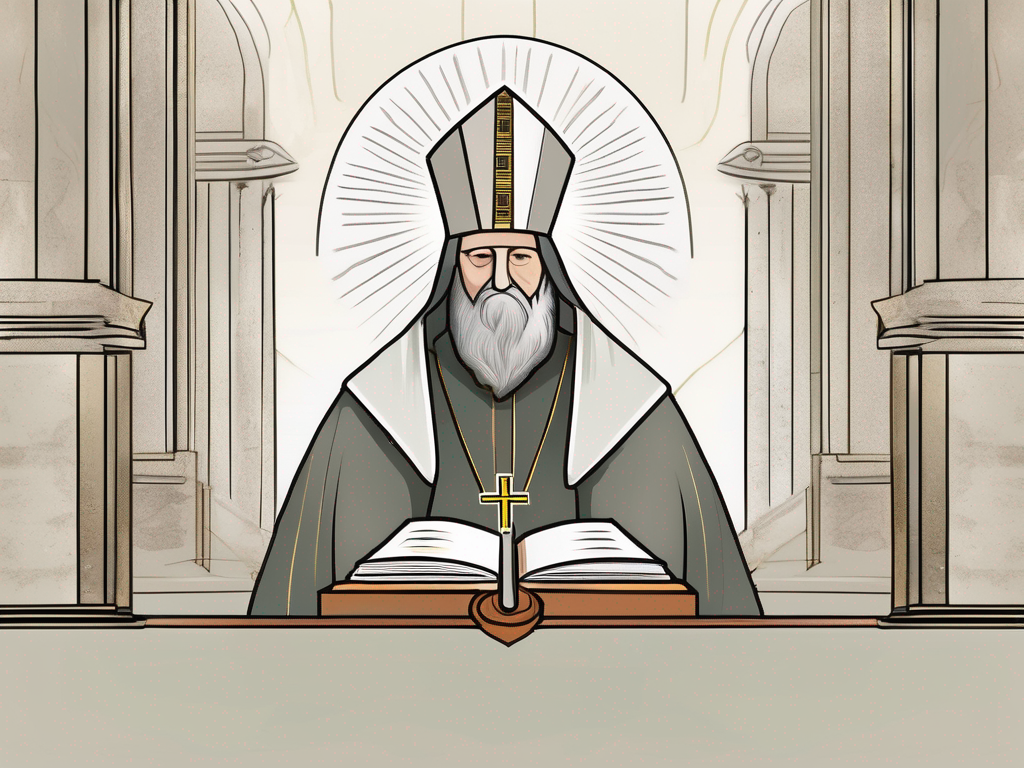Saint Cyril of Alexandria was a prominent figure in early Christianity, known for his influential role as the bishop of Alexandria in the 5th century. His life and legacy have left an indelible mark on the faith and continue to be studied and revered by believers across the globe.
Early Life of Saint Cyril
Saint Cyril’s journey began with his birth and family background. He was born in the city of Alexandria, Egypt, in the year 376. Coming from a well-respected family, he was fortunate to receive an excellent education, laying the foundation for his future accomplishments.
But let’s delve deeper into the early life of Saint Cyril. Alexandria, during that time, was a bustling city known for its rich cultural heritage and intellectual pursuits. It was a melting pot of different cultures, where Greek, Egyptian, and Roman influences intertwined. Growing up in such a vibrant and diverse environment must have had a profound impact on young Cyril.
During his formative years, Cyril immersed himself in religious studies and was greatly influenced by the teachings of his uncle, Theophilus, who was also a bishop of Alexandria. This early exposure to the ecclesiastical world ignited his passion for theology and shaped his unique perspectives.
As Cyril delved deeper into his studies, he became known for his exceptional intellect and dedication to learning. His thirst for knowledge led him to explore various branches of theology, philosophy, and literature. He engaged in rigorous debates and discussions with scholars and intellectuals of his time, honing his rhetorical skills and expanding his intellectual horizons.
Moreover, Cyril’s upbringing in a devout Christian family played a significant role in shaping his spiritual journey. From a young age, he was immersed in the teachings of the Church, attending religious services and participating in the rituals and sacraments. This early exposure to the faith instilled in him a deep sense of devotion and a desire to serve God.
As Cyril grew older, his reputation as a brilliant theologian and scholar spread far and wide. People from different parts of the world sought his guidance and wisdom. His eloquence and profound understanding of the scriptures made him a sought-after teacher and preacher.
It is fascinating to imagine the intellectual and spiritual growth that Cyril experienced during his early years. The city of Alexandria, with its vibrant intellectual scene, provided the perfect backdrop for his development. The teachings of his uncle, Theophilus, served as a guiding light, shaping his theological perspectives. And his unwavering dedication to learning and faith propelled him towards greatness.
Saint Cyril’s Ecclesiastical Career
After years of spiritual growth and learning, Saint Cyril ascended to the prestigious position of the bishopric of Alexandria. This significant appointment solidified his authority within the church and marked the beginning of his influential career.
As bishop, Cyril established himself as a strong leader, guided by his belief in the importance of the unity of the church. He championed key teachings and philosophies, emphasizing the divinity of Christ and the role of the Virgin Mary as the Theotokos, the God-bearer.
Under Cyril’s leadership, the Diocese of Alexandria flourished. He dedicated himself to the spiritual well-being of his flock, tirelessly working to spread the teachings of Christianity and strengthen the faith of his congregation. Cyril’s sermons were known for their eloquence and depth, captivating the hearts and minds of those who listened.
One of Cyril’s most notable contributions was his involvement in the Council of Ephesus in 431. This ecumenical council was called to address the heresy of Nestorianism, which denied the unity of Christ’s divine and human natures. Cyril played a pivotal role in defending the orthodox belief in the hypostatic union, asserting that Christ was one person with two distinct natures, fully God and fully man.
Throughout his career, Cyril also focused on combating various theological controversies that threatened the unity of the church. He engaged in vigorous debates with prominent theologians and philosophers, using his extensive knowledge of Scripture and his deep understanding of Christian doctrine to refute heretical teachings.
Furthermore, Cyril was a tireless advocate for the poor and marginalized. He established numerous charitable institutions, providing food, shelter, and medical care to those in need. His compassion and generosity earned him the respect and admiration of both Christians and non-Christians alike.
As a prolific writer, Cyril left behind a rich legacy of theological works. His writings explored a wide range of topics, including the nature of the Trinity, the sacraments, and the interpretation of Scripture. His profound insights and theological acumen continue to inspire and guide theologians to this day.
Saint Cyril’s ecclesiastical career was marked by unwavering faith, intellectual brilliance, and a deep commitment to the unity and well-being of the church. His contributions to Christian theology and his tireless efforts to defend orthodox teachings have left an indelible mark on the history of Christianity.
Controversies and Conflicts
However, not all aspects of Saint Cyril’s career were smooth sailing. He found himself embroiled in controversies and conflicts, the most notable being the Nestorian controversy. This dispute revolved around the nature of Christ and whether he was of one nature or two natures.
The Nestorian controversy was a theological debate that shook the foundations of the early Christian church. Saint Cyril, as the Archbishop of Alexandria, played a pivotal role in this conflict. He vehemently defended the belief that Christ had one nature, known as the “hypostatic union,” which combined both his divine and human nature. This position stood in opposition to the teachings of Nestorius, the Patriarch of Constantinople, who argued for a division between Christ’s divine and human natures.
The controversy reached its peak during the Council of Ephesus in 431 AD, where Saint Cyril led the charge against Nestorius. The council declared Nestorius a heretic and affirmed Saint Cyril’s teachings on the nature of Christ. However, this victory did not come without its own set of challenges.
Additionally, Saint Cyril faced conflict with Orestes, the governor of Alexandria at the time. The tension between the two arose from political and religious differences. Orestes, influenced by the pagan philosophers of the time, held a skeptical view of Christianity and its growing influence in Alexandria. This clash of ideologies led to a series of confrontations between Saint Cyril and Orestes, further complicating the already tumultuous atmosphere in the city.
Furthermore, the tragic death of the renowned philosopher and mathematician Hypatia added another layer of complexity to Cyril’s legacy. Hypatia, a prominent figure in Alexandria, was known for her intellect and teachings. However, she became a victim of the political turmoil and religious tensions that engulfed the city. Accused of being a pagan sympathizer, Hypatia was brutally murdered by a mob in 415 AD. While there is no direct evidence linking Saint Cyril to her death, his influence and the volatile climate of the time have led to speculation about his involvement.
These controversies and conflicts not only shaped Saint Cyril’s legacy but also had a profound impact on the development of Christian theology and the history of Alexandria. They serve as a reminder of the complexities and challenges faced by influential figures in times of religious and political upheaval.
Saint Cyril’s Writings and Works
Despite the challenges he faced, Saint Cyril found solace and expressed his theological insights through his extensive writings and works. Throughout his life, he composed numerous theological treatises and heartfelt letters, aiming to deepen the understanding of Christian doctrine and address the challenges of his time.
One of Saint Cyril’s most significant contributions was his work in Christology. He delved into the intricate relationship between Christ’s divine and human nature, exploring the depths of this mystery. These contributions have since been recognized and celebrated by theologians around the world.
One of Saint Cyril’s notable theological treatises is “On the Unity of Christ.” In this work, he eloquently explains the importance of understanding Christ as one person with two natures, divine and human. He delves into the complexities of this union, emphasizing the significance of Christ’s incarnation and its implications for humanity’s salvation.
In addition to his theological treatises, Saint Cyril also wrote numerous heartfelt letters. One of his most famous letters is the “Letter to Nestorius,” in which he passionately defends the title “Theotokos” or “Mother of God” for the Virgin Mary. In this letter, Saint Cyril argues that Mary’s role as the mother of Jesus, who is both fully divine and fully human, makes her deserving of this title. This letter sparked a significant theological debate and ultimately led to the Council of Ephesus in 431, where the title “Theotokos” was officially affirmed.
Saint Cyril’s writings and works were not limited to theological matters alone. He also addressed social and political issues of his time. In his letter “To the Emperor Theodosius II,” he pleads for the protection of the rights and privileges of the Christian community in Alexandria. He highlights the importance of religious freedom and the need for just governance to ensure the well-being of the Church and its members.
Furthermore, Saint Cyril’s works extended beyond the written word. He played a crucial role in the construction of the Church of the Holy Sepulchre in Jerusalem. This church, which is considered one of the holiest sites in Christianity, was built under Saint Cyril’s supervision. His dedication to the project and his desire to create a place of worship that reflected the significance of Christ’s crucifixion and resurrection is a testament to his deep faith and commitment to the Christian community.
In conclusion, Saint Cyril’s writings and works were diverse and impactful. His theological treatises, heartfelt letters, and involvement in significant projects demonstrate his dedication to the Christian faith and his desire to deepen the understanding of Christian doctrine. His contributions continue to be celebrated and studied by theologians and scholars worldwide, leaving a lasting legacy in the field of theology.
Death and Canonization
In his last years, Saint Cyril faced declining health but remained steadfast in his commitment to his faith and his responsibilities as bishop. He passed away in 444, leaving behind a legacy of theological brilliance and devotion to the church.
Following his death, Saint Cyril’s contributions to Christianity were widely acknowledged and celebrated. He was eventually canonized and became a revered saint in various Christian traditions, with his feast day celebrated on June 27th.
Canonization and Veneration
Saint Cyril’s canonization solidified his place among the great saints of the church. His works continue to be studied and respected, offering valuable insights into the complexities of theology and Christology.
Today, Saint Cyril of Alexandria remains an influential figure, remembered for his unwavering commitment to the faith, his intellectual contributions, and his dedication to church unity. His life and legacy serve as an inspiration for believers as they navigate their own spiritual journeys.












